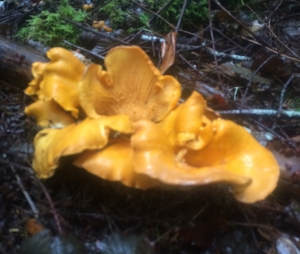 Cantharellus cibarius
Cantharellus cibarius
Also known as Gold Chanterelle, Girolle and Pfifferling. This beautiful dull yellow to bright orange Chanterelle looks as though someone has spread flowers all along the forest floor. This mushroom has a woodsy, apricot aroma that can be smelled throughout the forest where it is growing. The Yellow Chanterelle can be paired with lemon and other citrus and not loose its character. Try to stay away from strong herbs that will compete with the chanterelle flavor. Lemon thyme can be used in moderation. It is best to stay with butter, oil and light garlic. Chanterelles are good to pickle and use in salads or as a condiment. Drying is ok but the reconstituted mushroom can be disappointing. Chanterelles are often dirty, but when washed they soak up a lot of water, which can be disastrous in some recipes. But if you dry sauté them after washing you can add them to any dish with good results. Chanterelles make a great cream soup.
The cap of the Yellow Chanterelle is bald and broadly domed to nearly flat when it is young and becomes more concave or wavy as it matures. Well mature Yellow Chanterelles are refered to as flowers while the younger are called buttons. They range from pin head size to a 2-4 inches on average but can get bigger, flower. The color and size of the Chanterelle varies from region to region. The gills are well spaced, blunt, shallow, fairly thick with connecting veins and are the same color as the cap. The gills run down the stalk ,which is the same or slightly lighter in color as the cap. The stalk is solid not hollow. There is no ring, veil or volva on a Yellow Chanterelle. This mushroom is popular for the color, fruity fragrance and is usually worm or maggot free.
[…] Previous Next […]
[…] for the Hedgehog mushroom are Spreading Hedgehog and Sweet Tooth. This mushroom is a lot like a Yellow Chanterelle when cooking. Like the Yellow Foot Chanterelle the Hedgehog Chanterelle grows later in the winter […]